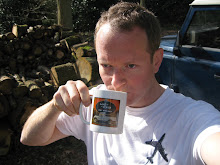This was one of the first air dried hams we had made. Our very first pigs were Oxford Sandy and Blacks.


They were four, very friendly gilts. Loved a good back rub and would roll over for a tummy tickle in an instant. Milo enjoyed chasing them and being chased by them all summer long. They spent the summer and early autumn running through bracken and making dens in the sunniest clearings where they lounged around like sleeping lions. (That should have been a clue that I was over feeding them).
In due course they reached a good size and took the short one-way road trip to sunny Farnborough. That weekend, Angelique, Rob, Fothers, Meyrick and I set about turning them into hams, salamis and sausages. We all opted to have a go at making our own air dried hams which involved packing a ham in salt for some weeks under weights of about 2.5 times the weight of the ham. The hams then hung in a dry and draughty place for a few months.
As far as I remember, the results were a bit mixed. I think everyone said they liked their hams but I'm not sure they all got completely eaten. On the whole they were too salty and too well cured. I think most favourably described as a 'rustic Serrano'. There was also some confusion around whether to cover in lard and spices before hanging or after.
Anyway, I had made two of these rustic serrano hams. We ate one over the next few months and I followed some old sage's advice and packed the second ham in ash for the next 12 months. And here it is...
 A bit musty after all this time but not putrid. I brushed it down and then cleaned up the explosion of mess I'd made in the 'charcuterie room'.
A bit musty after all this time but not putrid. I brushed it down and then cleaned up the explosion of mess I'd made in the 'charcuterie room'.Here it is sliced open. I had to hunt around for a solid section. Any bits with folds or air pockets looked a bit manky. I think it would have been better to have either used more weights or cure it bone in with an injection cure around the bone. Something I think Bod and Rob are experimenting with on their most recent hams.

And here is the finished product. Looks great but I'm afraid it is still brutally salty and doesn't taste much different for all the time it spent in wood-ash. I think that it could be because it was so completely cured when it went in, there was very little moisture left and hence very little exchange of cure and moisture between the outside and the centre.
 While the outcome was mildly disappointing I will have to wait on the more recent experimental research for the other members of the Ham Team. However, the ham from Chamonix was superb and an excellent reminder of how much harder it is to make this stuff than it first appeared. It goes exceedingly well with cheese too.
While the outcome was mildly disappointing I will have to wait on the more recent experimental research for the other members of the Ham Team. However, the ham from Chamonix was superb and an excellent reminder of how much harder it is to make this stuff than it first appeared. It goes exceedingly well with cheese too.

You should salt for 2/3 the normal time if you want to store in ash - the ash won't cure it. Bone out, salt in, shake it out - do this a few times and the cover with salt and put weigh on, double its own will be fine. After the salting, say a fortnight, take the ham out of the salt, rinse, dry and hang it in a good breeze. After 6 or more months take it down and bury in ash. The ash won't do much to the flavour, it is just a safe storage place really.
ReplyDelete